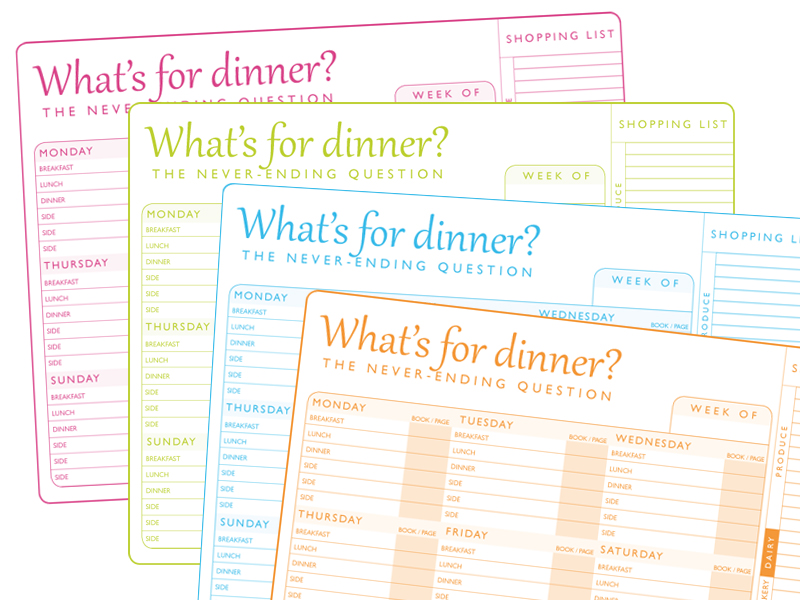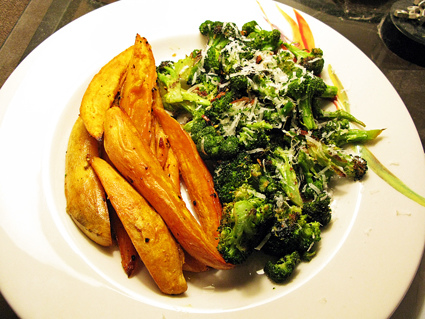By Bianca Tamburello, Dietetics Student, Sargent College
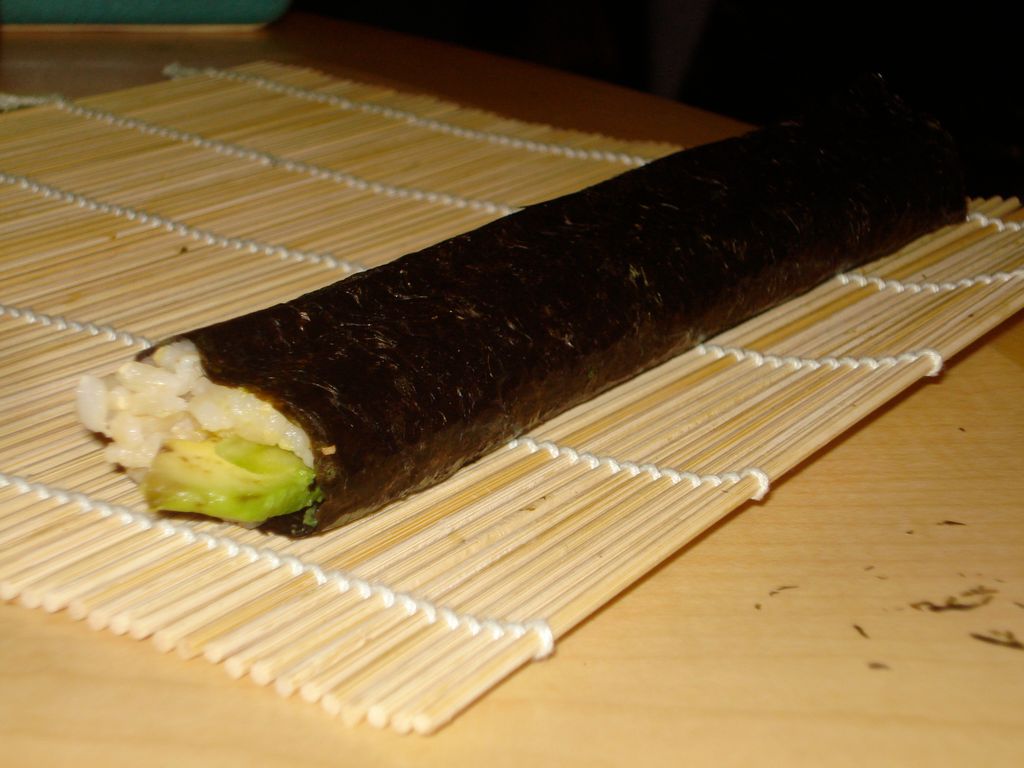
Sargent Choice Vegetarian Brown Rice Sushi was back by popular demand at Karen Jacob’s test kitchen last week! At previous test kitchen nights, I was often told that this is the most awaited recipe of the semester and a SC favorite.
Sargent Choice is lucky enough to have their own sushi expert, Karen Jacobs, who revealed her secrets to assembling the perfect roll. Sushi is a recipe that I have always intended on trying in my own kitchen, but I must admit, the rolling and raw fish intimidated me.
Before arriving at the test kitchen, I had already convinced myself that my sushi roll would fall apart and I would walk all the way back to my dorm as a sad sushi-less college student. But I actually did it: I successfully rolled my own sushi roll on my first try!
I know that I’m not the only cook who has shied away from making her own sushi in the past, so I’m going to bust some common myths right now:
Myth #1: Sushi rolling mats are essential for sushi rolling.
Sushi rolling mats are wonderful tools for rolling, but they are NOT essential for sushi making. Use the nori sheets as both an ingredient and a rolling mat. As we demonstrated at the test kitchen, spread the rice on the end of the nori, pile your vegetables on top and start to roll. Using this technique, the nori will surround the rice and hold the vegetables together.
However, if you prefer the rice on the outside of the roll and the nori on the inside, you may consider buying a sushi mat.
Myth #2: Brown rice is not sticky enough to hold sushi rolls together.
I must admit I have bought brown rice sushi that fell apart because the brown rice was not sticky enough. Karen Jacobs advises that the right amount of rice vinegar is the key for proper adherence, regardless of the type of rice. As directed in the recipe below, 2 tablespoons of rice vinegar for every 2/3rds of brown rice makes the brown rice just as sticky as white rice.
Myth #3: Sushi making ingredients are expensive.
This is where being a vegetarian for a night is very advantageous. Making vegetarian sushi instead of the traditional fish sushi cuts down on costs and relieves the pressure of finding an often-expensive, trust-worthy fish market. So save yourself the money and worry by packing your sushi with fresh vegetables and tofu, believe me you will not be disappointed!

First, we cooked the brown rice according to the directions on the package. As you may notice from the pictures, we did not add soy sauce to our brown rice. Soy sauce can be added by preference and is not necessary for proper binding of the rice. However, the rice vinegar is very important for the binding and the secret to neatly rolled sushi, so be sure not to skimp on the rice vinegar. The rice was transferred to another bowl where it was cooled and tossed occasionally.
Another trick to avoid the unraveling of your sushi roll is periodically dabbing your fingers with water and moistening the ends of the nori. Once the rice was prepared, we dabbed our fingers in a small cup of water and carefully spread out about 1 ¾-inch border of brown rice onto the nori. Next, we added the cucumbers, carrots, avocado slices, tofu and sprouts.
Everyone has different preferences for vegetables, so feel free to get creative! There is virtually no vegetable that cannot be rolled into a sushi roll. We even tested making sweet potato sushi at the test kitchen. We found that the sweet potato gave the roll a perfect hint of sweetness.
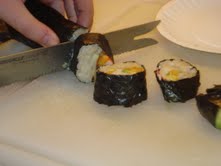
Finally, we dabbed the bare side of the nori with water and rolled the rice and vegetable end of the nori toward the opposite end, as we firmly held the filling in place. At the end of the roll, we dabbed the ends of the nori once again to seal the roll. We let the sushi sit for about 5 minutes, dampened a knife with water and then cut each roll into 6 pieces.
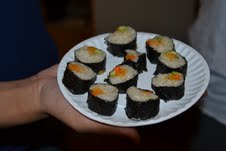
Sushi is not only delicious, but makes for a fun activity to do with friends and neighbors. Try hosting a sushi-making night and make it a competition as to who can make the most creative roll.
Sargent Choice Vegetarian Brown Rice Sushi
Yield 2 servings, 6 rolls each
Ingredients
2/3 cup dry short-grain brown rice
1-cup water
1-teaspoon water
2 teaspoons light soy sauce
2 tablespoons seasoned rice vinegar
1-teaspoon wasabi powder
2 (8 ¼ by 7 ¼ -inch) sheets roasted nori (dried layer)
½ Kirby cucumber, peeled, seeded, and cut into 1/16-inch thick matchsticks
½ medium carrot, cut into 1/16-inch-thick matchsticks
½ small California avocado, peeled and cut into thin slices
¾ ounces radish sprouts, roots trimmed
6 ounces firm tofu, cut into several long pieces
Directions
1. Prepare brown rice as directed with 1 teaspoon soy sauce
2. While rice is standing, stir together vinegar and remaining teaspoon soy sauce
3. Transfer rice to a wide, nonmetal bowl and sprinkle with vinegar mixture. Toss gently with a large spoon to combine. Cool rice, tossing occasionally, for about 15 minutes.
4. Stir together wasabi and teaspoon of water to form a stiff paste. Let stand for at least 15 minutes to allow flavors to develop.
5. Arrange 1 sheet of nori shiny-side down on a sushi mat lengthwise. With damp fingers, gently press half the rice onto the nori with a 1 ¾-inch border on the farthest edge.
6. Starting 1-inch from the side nearest you, arrange half the cucumber matchsticks, carrot matchsticks, avocado slices, and tofu pieces in an even strip horizontally across the rice (You may need to cut pieces to fit). Repeat with half the radish sprouts, letting some sprout tops to extend beyond the edge.
7. Roll the bottom edge of mat toward the top edge while holding the filling in place and pressing firmly to seal roll. Let stand for 5 minutes with the seam down and cut crosswise into 6 pieces with a wet knife.
8. Repeat steps 5-7 with the second sheet of nori.
| 1 Serving |
|
| Calories |
250 |
| Fat |
10 g |
| Saturated Fat |
1.5 g |
| Protein |
12 g |
| Carbohydrates |
28 g |
| Fiber |
6 g |



